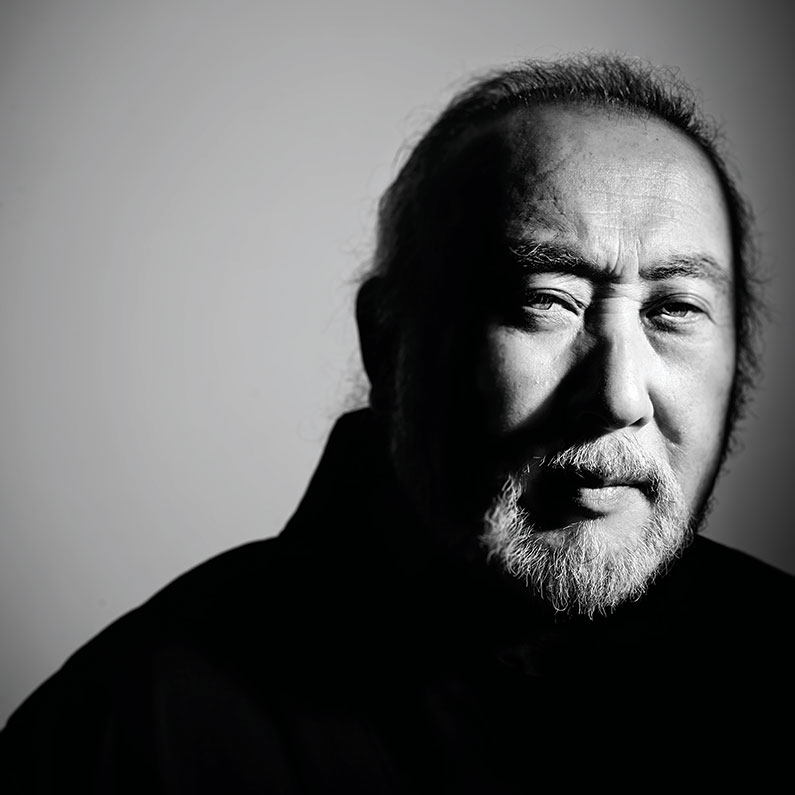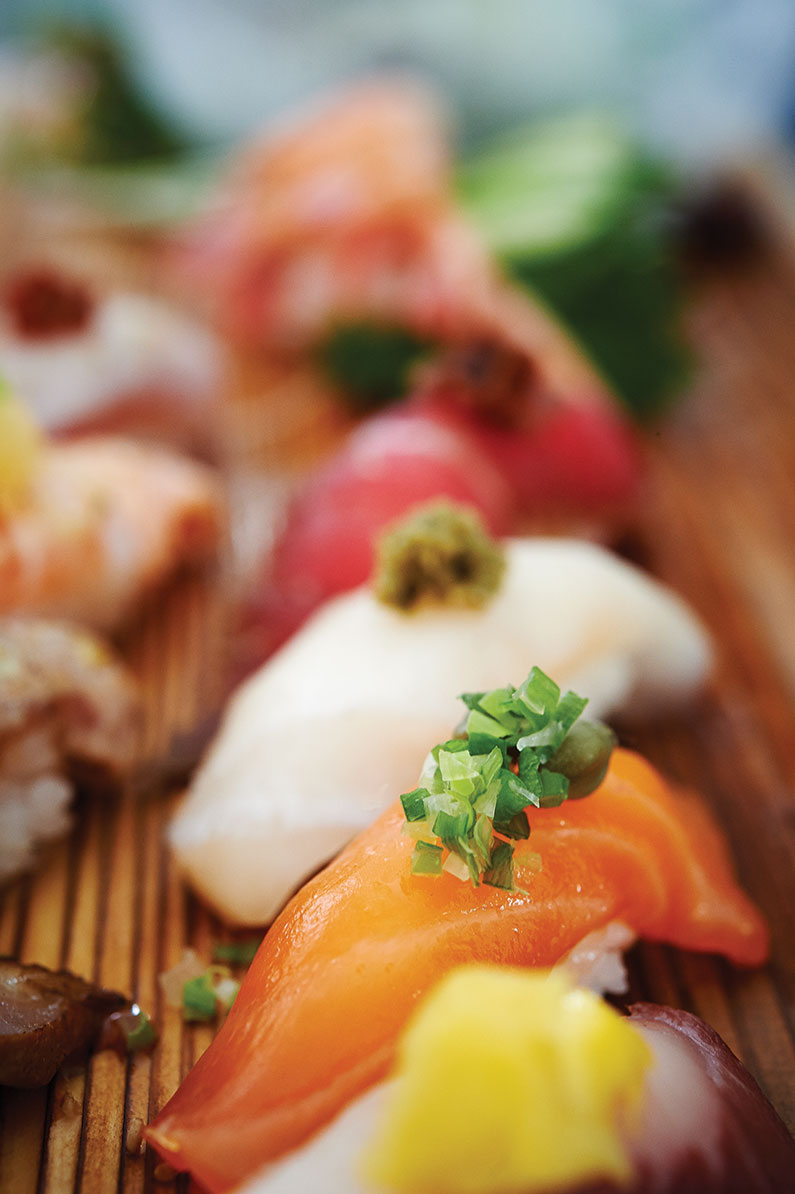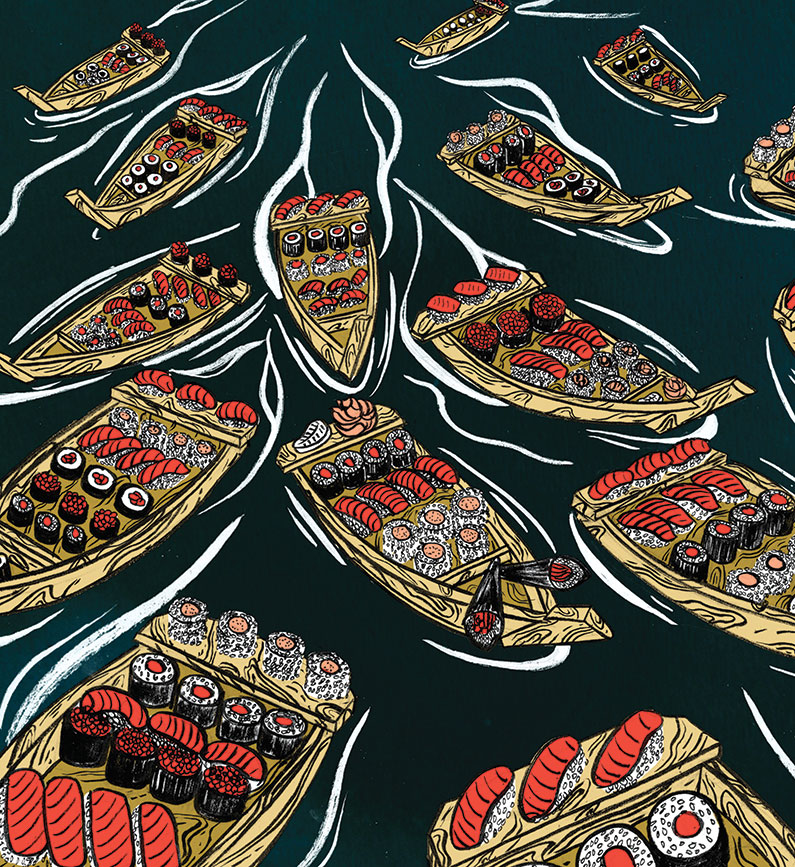Naomi Hamamura: A chef whose actions speak louder than words
CHAPTER 1
Dragon & Moon
Against the cold, cobbled streets, a chainsaw roared like a weapon, but Naomi Hamamura wielded it like a paintbrush, stroking the 300-pound block of ice softly and deliberately.
Seemingly unaware of the crowd pressing in around him or even of the unforgiving late-January chill, Hamamura set his chainsaw down just long enough to wring water from his thin cloth gloves. On his worktable rested a die grinder, household iron, hand broom, chisel and a pair of ski goggles. With these and two more hours, he would transform the icy behemoth into a willowy, winged fairy, his entry for the Master Carver competition at the annual Fête de Glacé in St. Charles.
Across the street earlier that day, Hamamura, called Hama or Hama-san by his friends and employees, also competed in the Monster Carver competition where, using a delicate system of melting and refreezing, he and a partner fused five blocks of ice totaling 1,500 pounds. The result was “Dragon & Moon,” a 7-foot-tall crescent moon rising out of an angry ocean, encircled by a serpentine dragon. On the other side of Main Street, Hamamura continued to carve his ice fairy under the afternoon shade, but now “Dragon & Moon” was thawing beneath the direct sun.

Ice carvings require patience and precision. If one section of a sculpture is finished too soon, its details might melt before the entire piece is completed. To be truly exceptional, though, a master carver not only knows how to make finishing touches all at once; he also anticipates how the sculpture will look once the melting begins. Hamamura’s friend Gary Suarez, a personal chef and fellow ice carver, attested to Hamamura’s ability to see a sculpture’s future. “His carvings melt perfectly,” Suarez said. “I’ve impressed myself with a couple of things I’ve done. I’d say my swan, because it took six hours (as) opposed to (Hama’s) 40 minutes, looked great. But three hours later, mine looked like a squirrel, and his still looked like a beautiful swan.”
To watch a masterpiece melt away while toiling over another work of art that will soon do the same seems like a Sisyphean punishment, but for Hamamura, his gray beard and black hat covered in ice chips, fingers numb, back aching from what would total more than eight hours of standing – these were the minutes he’d been waiting for. On any other day, he would have carved “Dragon & Moon” as part of his side catering and carving business, Chef De Art Catering, and would be off to his job as sushi chef of downtown’s Wasabi. But today, under the sun’s rays, water silently dripped from the dragon’s frozen fangs as more droplets shimmered from its rippling body, emerging from the swollen waves below. “Dragon & Moon” had come to life.

CHAPTER 2
To the Exact Degree
Hamamura was 20 years old and newly graduated from culinary school in Osaka, Japan, when he found his first cooking job at the nearby Royal Hotel. In 1970s Japan, the demand for ice carvings was growing exponentially. Although Hamamura wanted to learn the art, the Royal Hotel, one of the country’s largest hotels, already had more than 50 capable carvers. So after his shifts were through, he simply watched. More than two years passed before he felt ready to create carvings of his own.
In this era of dive-right-in learning and accelerated coursework, learning through seemingly endless observation sounds like some sort of austere Jedi training, but this process is the foundation of Japanese culinary culture. Hamamura estimates that in Japan, nearly everyone working in a reputable restaurant or hotel can be considered professionally trained because the employees have been hired to become chefs but are working their way up the pecking order. Your waiter is most likely a culinary school graduate who, after two years, still isn’t allowed near the stove. When Hamamura worked at Royal Hotel, the hotel hired only once a year, and what an employee was hired to do was his job until the following year. However, when the 365 days were up, and he finally got to move from, for instance, soapy sink to saute, there were no explanations, no training and certainly no textbooks. It was up to him to have learned the next job during off hours. If he didn’t know how to saute perfectly on his first day, he was back to washing dishes.
During culinary school, Hamamura took courses in both French and traditional Japanese cuisine, but when he started his job, the hotel was in dire need of a baker. Anxious for the honor to wear his chef whites, Hamamura jumped at the chance. For an entire year, part of his job was to take the temperature of bread dough. Rather than treat the mundane task like a chore, Hamamura welcomed it as a challenge, sticking his finger in the dough every time he inserted the thermometer. Eventually, simply through how the dough felt to his finger, he could discern the temperature to the exact degree.
While this Japanese culinary training system is painfully slow, perhaps that is why the itamae, or sushi chef, is a better observer than anyone. From his position behind the bar, he can better discern his customer’s tastes and experience level. If a customer orders sashimi to test the restaurant’s quality of fish, a sushi chef might grow interested. If the customer orders nigiri, an oblong-shaped, hand-pressed mound of rice topped with fish, and ignores the glob of green wasabi to the side, the chef’s attention will be piqued. And if the customer skips ordering all together and simply utters omakase, the sushi chef will be electrified. As Hamamura’s daughter Heidi Hamamura described, omakase means: “I trust you. Make me the best food you have.”

CHAPTER 3
78 Grains of Rice
In 1979, Hamamura arrived at Lambert International Airport in search of a placard with his name on it. “He looked like a gangster with his curly hair and mustache,” said Heidi Hamamura, laughing as she described pictures of her father at 26 years old. Unable to locate his ride and knowing little English, he found a phone book, carried it to a taxi and pointed: Robata of Japan. After a year working at the now-defunct Japanese-style steakhouse, Hamamura moved on to a variety of jobs. He was chef d’arte at the Ritz-Carlton, shaping or carving everything from ice to sushi to watermelon to chocolate. Later, he taught ice-carving courses at Forest Park Community College. In 1998, when a friend was looking to sell his business, Hamamura bought the Japanese restaurant Sansui in the Central West End.
In 2010, Hamamura sold Sansui to some of his employees, who renamed it Kampai. By then, he also owned Sansui West in Glendale and was happy to have just one sushi bar to stand behind. Two years later, Sansui West was also bought, this time by local sushi chain Wasabi. For many St. Louis sushi eaters, this final sale signaled the end of an era, but their Camelotian memories live on.
Eric Kelly, former chef-partner of Scape American Bistro, remembers walking into Sansui West and being enchanted by the large photograph of Hamamura making sushi as Paul Bocuse stood beside him, his arm over Hama-san’s shoulder. “Paul Bocuse – the grandfather of chefs, absolutely the biggest influence in our craft throughout the world – there he was in a big, beautiful picture with Hama,” Kelly said.
Many of Hamamura’s closest friends met him at his sushi bar. “A relationship with a sushi chef is a lot like a bartender. You have to cultivate it,” said Dave Lowry, author of “The Connoisseur’s Guide to Sushi” and restaurant critic for St. Louis Magazine.
Lowry recalled Hamamura’s ura kondate, his unpublished menu-behind-the-menu, as being particularly impressive. He also remembered the rice, perfectly seasoned and served at the right temperature. “Sushi has standards. It’s about the rice,” Lowry said. “What comes on top is purely secondary. Hama and Nobu (Nobura Kidera, chef-owner of Nobu’s) know how to make sushi rice.”
Gary Suarez, Hamamura’s longtime friend, felt Sansui West was his country club because not only did he always feel welcome, he also knew the meal was going to be the best thing he had that week. “He would always hand me new things,” Suarez said, recounting the time Hamamura sent out a plate of horse mackerel tartare garnished with its bones. When Suarez finished, he left the bones on the plate, but for the next course those same bones came out again, this time deep-fried. Then there were the apples. “When I would go into his restaurant in early October, if it was slow, he would be sitting there carving faces in apples, to shrink, so that by the time Halloween came around, he would have them hanging all over – a restaurant of shrunken heads,” Suarez said. “He didn’t need to spend time or money doing that, but he wanted to.”

Landlocked St. Louis took longer than the coasts to join the sushi craze, but by the mid-2000s, sushi in the Gateway City was ubiquitous – pre-packaged rolls were sold in grocery stores and shiny sushi lounges had popped up in every suburb. Yet what the sushi neophytes were actually craving were Americanized maki: rolls stuffed with cream cheese, covered in deep-fried crunch, crisscrossed in colorful sauces that were then dunked in a slurry of wasabi and soy sauce; the actual fish inside was rendered all but undetectable. Time and again, Hamamura’s admirers reverently spoke of his attention to ingredients and flawless execution. But how long could one pursue perfection when more and more people were unwilling to notice?
From an economic standpoint, it made sense that the newer sushi bars were catering to the masses. “In Japanese restaurants in the U.S., there’s an opportunity to (take advantage of) the American’s understanding of what you’re serving,” Suarez said. “I could very easily go out and get salmon and slap it on rice and put it out.” But Hamamura didn’t do that. He sought the highest-grade fish, even though most of his clientele couldn’t tell the difference.
Suarez recalled Hamamura showing one of their friends how to make nigiri. He and the friend both packed a pile of rice and put them side by side. Then he had the friend count the grains. “(Hama’s) had 78 grains of rice, and (the other) one had 134 grains. They were the same size but just the understanding of how to pack it,” Suarez said. While many chefs densely pack their rolls with rice, leaving a scant amount of meat or vegetables within, Hama used less rice and more fish. “When you’re just shoving sushi in your face, you don’t really notice it until someone points it out. As I started touring around the country going to other Japanese restaurants, I realized that I was really spoiled. I realized that unless I was spending a ridiculous amount for that sushi meal, I was getting inferior rice and inferior nori. People were not so concerned with putting the best product forward. Hama wasn’t one of these guys.”
After Wasabi bought Sansui West, Hamamura stayed on as its corporate chef, the assumption being that his job was to make the four existing Wasabis – five including the new acquisition – more like Sansui. He was also responsible for ensuring Wasabi’s products were consistent and for overseeing the company’s catering division. However, after less than a year, Hamamura was ready to leave. He moved to Prasino in St. Charles, the first Missouri location for the regional chain of eco-friendly restaurants. There he helped executive chef Tony Marchetto design the sushi menu. “He helped me learn the ins and outs – practices in rice and how to cut fish. I learned so much from him,” Marchetto said. A workhorse by nature, Hamamura enjoyed his new role at Prasino. But when Wasabi called last fall, offering him free rein over its flailing flagship location downtown, although hesitant, he had a hard time resisting the challenge. Today, it is the only Wasabi location offering a specials board. “We call it Hama’s test kitchen, where he can play around, try new recipes,” said Sarah Lee, regional operations manager of Wasabi.
While Hamamura’s last few years have been marked by change, he doesn’t view it with lassitude, but rather as an opportunity for him to grow and improve his craft. It’s experience where he also looks when forming his definition of umami, the Japanese word used to describe the nebulous fifth taste so central to Asian cuisine. For him, umami is more than a subjective savory flavor. One can’t grasp it without experience.
Consider the sea bream, <tai in Japanese, which have the very best flavor during Japan’s season of cherry blossoms, Hamamura explained. While the advancing blooms signal the onset of warmer weather, starting in the south and moving up Japan’s archipelago through March, April and May, they also symbolize the evanescent nature of life. From steep cliffs and rocky faces to the banks of the rivers, pink bursts of extreme beauty envelop Japan. But in less than a week, the fragile flowers fall and won’t emerge again for another year. For Hamamura, even though tai tastes best during this season, one must eat it all year. Only that way can one appreciate its rich flavor, realize umami and understand that there is a season for everything before it vanishes.

CHAPTER 4
Sushi by the Boatload
Hamamura’s hands fly into a frenzy and, seconds later, come to a halt, landing on tweezers he uses to place individual radish sprouts onto tsukidashi – a salad of sliced squid, cucumber, daikon radish and bright orange ovals of capelin tobiko.
Tonight I am eating omakase-style at Wasabi downtown, and Hamamura’s signature amuse-bouche is only the opening salvo. For the first course, he sends avocado slices wrapped tightly into a ball. I pull the slices back, like petals from a tulip, to discover pink cubes of lightly smoked salmon sprinkled with capers. Hamamura considers the pre-smoked salmon that most sushi restaurants purchase too salty, so he brings in his own smoker and cold smokes it himself.
New plates arrive and are ushered away. By the fourth course, Hamamura has piled pieces of delicate horse mackerel on shiso leaves topped with scallions and freshly grated ginger. The sixth course is skate wings in a sake brown butter sauce – another favorite inherited from Sansui. After a seventh course of nigiri, one of the pieces topped with a seared hunk of foie gras, I raise my hands in stuffed surrender.
After living in St. Louis for almost 35 years, there are certain things Hamamura will never understand, like why people drink miso soup with a spoon. (You might as well drink coffee with a spoon, he offers in comparison.) He’s been able to change some things. When he started his job downtown at Wasabi, the chef side of the sushi bar was too high for his liking. He insisted that the bar be remodeled so he could observe and interact with his diners at eye level.
But there are aspects of St. Louis sushi beyond Wasabi that Hamamura fears have become far too adulterated. Eliot Harris, owner of the food truck Chop Shop STL and former sushi chef at Miso on Meramec, seconded sushi’s current plight. “Chefs like Hama, Kenji [associate of Harris and former Sansui chef] and myself aspire to open a sushi bar like Sidney Street or Niche without being a roll manufacturer all night long, but it’s pretty impossible in the St. Louis market. For people to be willing to pay the price to have excellent cuts of fish flown in fresh every day, it would take some sort of cult following.”
Still, Hamamura keeps his hands busy. On Monday nights at Wasabi, he makes sushi by the boatload, literally. Owing to the Monday happy hour special, the restaurant is packed and the phone rings endlessly with to-go orders. Atop miniature wooden Japanese boats and bridges Hamamura arranges pieces of sashimi fashioned in the shape of roses, an array of nigiri and every imaginable iteration of roll.
When I am there, Hamamura loads up another wooden boat. The Japanese style of presenting rolls calls for laying the pieces on their sides and overlapping them in a line, like dominoes, so the contents of each piece can be admired. Even though the majority of the rolls he prepares quickly become Americanized by squirts of sauces and layers of crunch, he still carefully positions each piece, including the ones placed in the stacks of Styrofoam boxed to-go orders the servers quickly haul away.
Yet even on Monday nights, when his sushi bar becomes a discounted roll circus, Hamamura enjoys what he does, as he always has. Some people have a job and a hobby, but for him, ice sculpting and food are his hobbies. He hopes to do them until his body stops working. And there are always glimmers of light: the man eating solo at the end of the bar, quietly requesting more nigiri; the table of co-workers erupting with delight when a sushi-loaded ship arrives at their table; and Hamamura’s ability to retain his artistic license and use it, as with the crappie he caught the day before, which he fries, pickles and plates before silently sliding it my way.

CHAPTER 5
Where there is Water
Hamamura grew up smelling the Sea of Japan in the city of Hagi in the Yamaguchi prefecture. As a child, he was at the water’s edge every day, either fishing or daydreaming about one day captaining a great ocean liner. But in junior high, he was told he was partially colorblind and would never steer any such ship. Around that time, cruise boats were starting to arrive in the ports of Japan. Young Hamamura watched TV commercials for the ships, which always featured decadent buffets complete with elaborate ice carvings. It was then that he decided his next profession. As a chef, he could work on a cruise boat and travel the world.
By the time he graduated from culinary school, Japan’s cruise industry had all but vanished. Eventually his cooking did bring him across water, but nowhere near an ocean. So Hamamura has found solace in the next best thing: Sometimes for a weekend, and sometimes just for an afternoon, he drives an hour south to a lake owned by a friend, who like many, started as a customer.
Although he is often in the company of family and friends, at some point during his visit, Hamamura finds a moment to paddle out to the middle of the lake in the canoe he fashioned by hand. With only room for himself, his fishing pole and his tackle box, he will throw out his line and, eventually, rest his head back and fall asleep.
Tags : People






